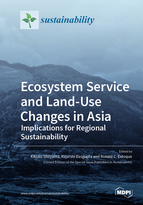Ecosystem Service and Land-Use Changes in Asia: Implications for Regional Sustainability
A special issue of Sustainability (ISSN 2071-1050). This special issue belongs to the section "Environmental Sustainability and Applications".
Deadline for manuscript submissions: closed (30 June 2022) | Viewed by 69857
Special Issue Editors
Interests: socio-ecological systems; land-use change; ecosystem services; disaster resilience
Interests: ecosystem services; landscape planning; conservation; socio-ecological systems
Special Issues, Collections and Topics in MDPI journals
Interests: sustainability science; land change science; forest transition theory; forest monitoring; sustainable forest management; ecosystem services; climate change; GIScience and remote sensing
Special Issues, Collections and Topics in MDPI journals
Special Issue Information
Dear Colleagues,
Asia is expected to experience population growth, peaking around 2030–2060 (World Population Prospects 2019), which will likely result in unpredictable socio-economic changes that will present new challenges for land management. Sustainable land and natural resource management will play a crucial role in addressing these issues in the region. In particular, assessing land-use change and its effects on ecosystem services (ESs) is necessary to foster regional sustainability.
In response to the trade-offs in multiple land use, the concept of ESs has been introduced to find synergies between nature conservation and other aspects of human wellbeing. In recent years, many studies have addressed the impacts of land-use change on bundles of multiple ESs by considering the influences of direct and indirect factors, e.g., region-specific changes in population and other socio-economic statuses. These case studies have provided insight on how land use, with the interaction of historical land management, has configured the ESs provided by ecosystems. Thus, the findings from such empirical studies contribute to developing sustainability in Asia, at both local and regional scales.
In this Special Issue, we will focus on qualitative and quantitative analyses of ESs specifically toward sustainability in Asia. The Special Issue will include, but will not be limited, to case studies, conceptual or analytical reviews, and policy-relevant articles toward achieving the 17 SDGs in Asia. Contributions can be in the form of articles, reviews, and perspectives and viewpoints.
Dr. Kikuko Shoyama
Dr. Rajarshi Dasgupta
Dr. Ronald C. Estoque
Guest Editors
Manuscript Submission Information
Manuscripts should be submitted online at www.mdpi.com by registering and logging in to this website. Once you are registered, click here to go to the submission form. Manuscripts can be submitted until the deadline. All submissions that pass pre-check are peer-reviewed. Accepted papers will be published continuously in the journal (as soon as accepted) and will be listed together on the special issue website. Research articles, review articles as well as short communications are invited. For planned papers, a title and short abstract (about 100 words) can be sent to the Editorial Office for announcement on this website.
Submitted manuscripts should not have been published previously, nor be under consideration for publication elsewhere (except conference proceedings papers). All manuscripts are thoroughly refereed through a single-blind peer-review process. A guide for authors and other relevant information for submission of manuscripts is available on the Instructions for Authors page. Sustainability is an international peer-reviewed open access semimonthly journal published by MDPI.
Please visit the Instructions for Authors page before submitting a manuscript. The Article Processing Charge (APC) for publication in this open access journal is 2400 CHF (Swiss Francs). Submitted papers should be well formatted and use good English. Authors may use MDPI's English editing service prior to publication or during author revisions.
Keywords
- land-use and cover change
- biodiversity and ecosystem services
- nature’s contributions to people
- landscape sustainability
- sustainability assessment
- SDGs
- future scenarios
- spatial analysis
- GIS and remote sensing
- transformative change
- nexus of food, water, and energy
Benefits of Publishing in a Special Issue
- Ease of navigation: Grouping papers by topic helps scholars navigate broad scope journals more efficiently.
- Greater discoverability: Special Issues support the reach and impact of scientific research. Articles in Special Issues are more discoverable and cited more frequently.
- Expansion of research network: Special Issues facilitate connections among authors, fostering scientific collaborations.
- External promotion: Articles in Special Issues are often promoted through the journal's social media, increasing their visibility.
- Reprint: MDPI Books provides the opportunity to republish successful Special Issues in book format, both online and in print.
Further information on MDPI's Special Issue policies can be found here.








